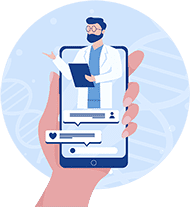RPM Benefits both Physicians and Patients
There’s been a lot of talk lately about how technology can revolutionize healthcare, and one way is through the use of remote patient monitoring. By gathering health data and insights on your patients’ conditions without the necessity of in-person visits, you’ll be able to provide improved quality of care for a lower cost, thus fulfilling the purpose of value-based care.
What is Remote Patient Monitoring?
Remote Patient Monitoring, often identified as RPM, collects medical and health data from patients located outside of a medical facility using digital technologies and transmits that information to providers securely for the purpose of assessment and, as needed, action. RPM is particularly useful when monitoring patients who have recently been discharged from inpatient care or who have undergone a surgical procedure, as well as those with chronic illnesses. Through the use of RPM, physicians can monitor data such as weight, vital signs, blood oxygen levels, blood sugar, and heart rate without having the patient visit the office directly. In doing so, providers are able to get a much clearer overall picture of their patients’ health status rather than the disjointed snapshots that providers have typically had access to based upon the frequency with which patients visited their provider.
How does RPM impact the physician?
Remote patient monitoring has the ability to provide a few very important benefits to providers, the first of which is increased ease in accessing patient health data. Typically, providers have access only to disjointed snapshots of their patients’ health, determined by how frequently those patients come in for a visit. With RPM, though, patient health data can be transmitted to the provider daily, allowing for trends to be identified earlier and emergency situations to be avoided.
The next benefit of RPM use is the ability to provide more patients with a higher quality of care without facing burnout. Many providers simply don’t have the time to give undivided, personalized attention to every patient. With RPM, patients are consistently monitored in their home and alerts can be sent to the provider when a trend in the patient’s health data warrants attention. In that way, providers can provide that higher quality care, but without sacrificing their sanity. Finally, all of this adds up to lower health costs and higher levels of efficiency. By reducing hospitalizations and readmissions, health care costs are kept down while patient health outcomes are increasing. Being able to monitor all chronically ill patients without having to have an active eye on them increases provider efficiency by allowing them to provide a higher level of care than ever before without increasing the amount of time they spend actively monitoring patients.
How does RPM impact the patient?
Obviously when providers are able to be more attentive and effective, that’s a benefit to patients, but the impact of RPM doesn’t stop there. Remote patient monitoring also provides patients with better access to the care they need. It’s been a major topic of discussion that with the increases in the number of insured patients in this country and insufficient growth in the number of healthcare providers, it’s becoming more difficult than ever to have access to a caregiver. By utilizing remote patient monitoring, many conditions can be addressed from a distance, leaving appointment times for situations that necessitate an in-person visit while still allowing all patients access to the care they need.
Another benefit for patients is improved quality of care. Because the use of remote patient monitoring connects patients more directly to their provider, keeping the flow of health data coming, it allows physicians to provide better more attentive care without great disruption to their schedule or facing the possibility of burnout. Additionally, the presence of RPM can increase patient engagement with their health, making them feel more accountable for their own care, and helping them to make better, more responsible choices. These pieces all come together to create better quality of care and therefore better health outcomes.
Assurance is another important benefit that patients in RPM programs will experience. Living with a chronic illness can be nerve-wracking, but the knowledge that someone is watching out for their well-being on a daily basis is valuable to provide a feeling of security for these patients.
Finally, is the education, support, and feedback that patients receive through the use of RPM. When patients are as connected to their providers as they are through remote patient monitoring, the providers are able to get valuable information to their patients on a more regular basis, insuring that patients understand their condition and how best to manage it.
Obviously there are a number of benefits to be realized through the use of RPM, but this is just the beginning. For more information on how RPM works, how go get paid for RPM services, and the various uses for RPM, check out our eBook.




